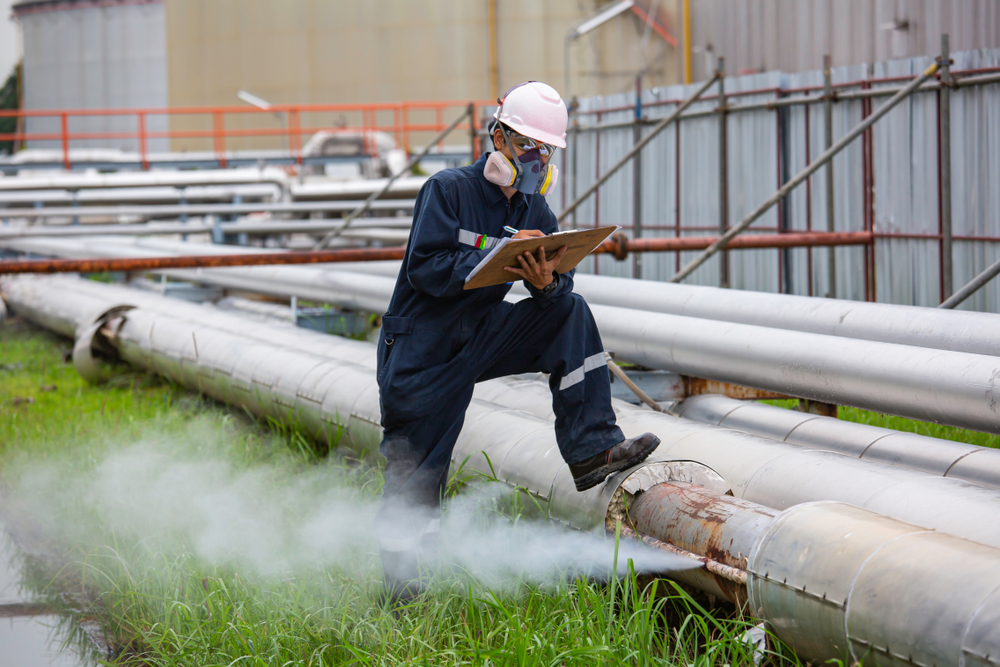Search
Static Electricity Hazards from Splash Filling, Steam Leaks, Spray Washing …

We’re going to look at fires and explosions CAUSED by static electricity on suspended liquid DROPLETS. Everything from steam leaks to spray washing, splash filling, to lightening is implicated here, so follow closely. We’re going to take you on a journey of discovery that begins in Old London Town, England, May 14th, 1853, where a crowd is gathered in the packed lecture theatre of the Royal Institution. But before we do, read this:
In Early 1970 the New York Times (Ref. 1) ran an article about the loss of THREE large oil tankers off the coast of Africa. Crew members died, were injured, or were reported missing as a result of explosions inside the holds of the ships. In all cases it was believed that the explosions had occurred during tank cleaning – a process involving the use of high-pressure water jets directed at the cargo-tank walls.
More recent: “I was walking through the plant, and something caught my eye. Was I really seeing a long, continuous spark adjacent to one of our low-pressure steam lines – and in the middle of the chemical plant? We handle flammables solvents. This is a classified Hazardous Location! The sparking was visible through a cloud of steam that seemed to have formed at a drain valve on the steam line. It looked like the spark was coming from the metal cladding that surrounded the insulation on the pipe.”
Something interesting is going on here. And it’s clear that that ‘something’ involves liquid droplets.
If you haven’t guessed already, that “something” has to do with static electricity, so let’s learn from the man who is considered to be one of the fathers of the subject; one Michael Faraday, who’s just appeared at the front of the London lecture theatre (May 14th, 1853) (Ref 2). A hush has descended on the room in the packed lecture theatre as the big man appears and gestures towards the equipment on the bench in front of him. We see a small boiler with a small-bore pipe attached; he’s generating a jet of steam. We also see a Layden Jar (an early form of capacitor) and a little gun powder on the bench. The steam issues forth from the pipe and is directed to the electrode of the Layden Jar which, in turn, and with a flash and a bang, spectacularly create a spark that ignites the gun powder. Steam charges capacitor; spark from capacitor ignites gun powder. The crowd is entertained and appreciative!
Modern Explanations of charging mechanisms
Most of us have a rudimentary understating of static electricity that says if you rub an insulator with another material, there a good chance that you will electrostatically charge the insulator (a process known as triboelectrification). If the insulator is a comb, for example, you might see or hear sparks as you comb your hair. But liquids don’t charge by the same mechanism and even today there are competing theories about how exactly liquids become charged. Double layers of charge form at the boundaries between liquid and container, as dipole liquid molecules orient at the interface, leaving the possibility of one polarity emerging dominant on droplets as they are formed on flow and breakup – in spraying or steam generation, for example. There is also an ‘ion fluctuation theory’ where liquids are seen as containing positive and negative ions and it is the fluctuation in the concentration of these ions that leads to net charge as a liquid breaks up into droplets (Ref 3).
The science of droplet charging mechanisms is perhaps of less interest to the process safety practitioner than the empiricist’s view which simply observes that water droplets – from spray nozzle, steam jets and even splashing liquids (e.g., splash filling) are experimentally found to be charged, and probably that the higher the energy of the droplet generation process, the more charge is likely to be generated. Examples of this in nature abound; waterfalls, where electrostatic measurements reveal the water spray to be negatively charged; thunderstorms where water droplets from condensation are produced in the atmosphere. It turns out that smaller water droplets tend to be negatively charged and the larger one positive. The different buoyancy and opposite polarity of large and smaller droplets leads to charge separation in the atmosphere – and thus to lightening.
On Plant Electrostatic Dangers
On process plant we see a number of situations where charged droplets are created. In our example above, a steam leak from a drain valve produces a jet of steam. The steam impinges on the steam pipe’s metal cladding that surrounds the insulation on the pipe, leaving charge on the cladding. If the cladding is not connected to ground, charge can accumulate on the cladding leading to sparks from the ungrounded cladding to nearby grounded metal plant components – for example a drain valve handle.
With spray washing of vessels, droplets are created at the spray nozzle – and as the jet impacts the vessel wall. Input energy to create the spray can be considerable, creating the prospect of a highly charged mist inside the vessel. This charged mist can induce charges on ungrounded plant components inside the tank – and even on people working in the vicinity of the spray. These effects have given rise to rules concerning the need to adequately ground all tank components inside tanks (for example, level sensors). And there are also rules concerning sampling from recently splash-filled vessels. Before sampling from a vessel that has been recently splash-filled, there should be a wait time – to give the opportunity for any lingering charged mist to settle and dissipate its charge. In the case of the oil tanker explosions described above, the ignition source was deduced to be charged slugs of oil/ water breaking away from the tank ceiling and sparking on contact with a grounded surface. These slugs became charged by induction from highly charges mists inside the tanks created during spray washing operation. It’s worth noting than pretty much ALL spraying and splash filling operations will generate some static charge on any mist generated AND on any components in contact or adjacent to the charged mists. Therefore, some precautions will be needed in the presence of flammable atmospheres to avoid the risk of fires and explosions. In the case of the oil tankers, a procedural change was introduced that involved displacing the flammable atmosphere inside the tanks by diversion of flue gases from the engines into the ship’s hold prior to spray washing.
In Conclusion
With any operation involving liquids that results in the formation of a mist, the risks from static electricity should be evaluated. Grounding and bonding is always the starting point to mitigate the risk, but as the oil tanker explosions demonstrated, grounding and bonding is not always enough. Sometimes process changes (use of dip pipes) or even introducing wait time have a role to play in building the safety case.
At Stonehouse, our specialist technical teams regularly undertake focused hazard assessments to assess the more complex questions associated with electrostatic hazards. Electrostatic measurements can even be used on plant to provide definitive answers to such questions when standards and guidelines reach their limits.
Ref 1: New York Times, Jan 7th, 1970, Static Electricity is Suspected of Tanker Blasts
Ref 2: Faraday on Static Electricity, Scientific American, May 14, 1853
Ref 3: T.V. Prevenslik, Bubbles and Steam Electricity

Get in touch
To learn more about our expertise and services in dust explosion prevention & mitigation, call us at +1 609 455 0001 or email us at [email protected] today.
We also offer tailored virtual and in-company process safety training programs on Dust Explosions, Static Electricity and HAC (Hazardous Area Classification) and more. Find further information here.









